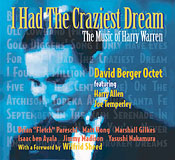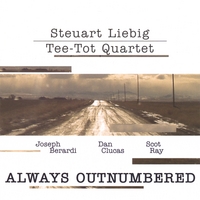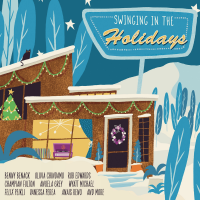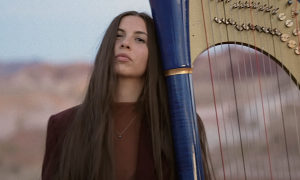Home » Jazz Articles » Interview » James Carter: Something Old, Something New
James Carter: Something Old, Something New
I just try to keep everything simple, saying, 'Look, this is the woodwind family.' As opposed to, 'This is the sax, this is the flute, this is the clarinet...'
 Multi-instrumentalist James Carter has always had eclectic tastes. That was evident on his debut, JC on the Set (Columbia, 1994), where the squeaks and blips linked him to the avant camp of Eric Dolphy and the tenor swoons nestled him comfortably within the traditional velvet of Coleman Hawkins and Ben Webster.
Multi-instrumentalist James Carter has always had eclectic tastes. That was evident on his debut, JC on the Set (Columbia, 1994), where the squeaks and blips linked him to the avant camp of Eric Dolphy and the tenor swoons nestled him comfortably within the traditional velvet of Coleman Hawkins and Ben Webster.
Subsequent releases found him venturing further along each of those paths individually, splitting the new and the traditional like Proust taking Swann's Way (1913) and The Guermantes Way/ (1921) separately so as to conquer and know the full character of each. Soon entire James Carter projects were devoted to exploring the work of a single artist—Django Reinhardt on Chasin' the Gypsy (Atlantic, 2000), Billie Holiday with Gardenias for Lady Day (Columbia/Sony, 2003) and rock band Pavement for Gold Sounds(Brown Brothers, 2005).
Carter's Present Tense (Emarcy, 2008) shows him bringing it all back home. There's a Reinhardt cover ("Pour Que Ma Vie Memeure"), an ode to Dolphy ("Bro. Dolphy") and a tune purportedly delivered to Carter in a dream by Lady Day herself ("Sussa Nita"). The Motown jump of his early records also makes a strong comeback.
Yet amidst any return-to-form talk, Carter has also made much of the increased lyricism in his playing. Does that mean the record serves both as a summation of his career to this point and a launching off into something new?
"Yeah, I would definitely say that, on both ends," Carter acknowledges via phone from his home in Detroit. But the spark of the new, he says, has always been part of his game.
"[I'm] not only willing to deal with other areas, but other people and personnel as well. It seems I have a ten-year itch regarding that, because back in '98 ... with In Carterian Fashion (Atlantic), that was the first signal that I had personnel changes. It's a good thing. The nuances, the different energies, and just being able to play with [new] people."
"At the same time ... you got to deal with the [music's] nucleus," he says. "I've always been a fan of people like Duke Ellington and [Count] Basie—those nucleuses that have been together for years, and the longevity and how you can [communicate] telepathically. It's just really hip."
As an example, Carter points to his seven-year musical relationship with drummer Leonard King and organist Gerard Gibbs, a partnership kicked off by the 2001 date recorded for Live at Baker's Keyboard Lounge (Warner Bros, 2004).
 "As far as I'm concerned the organ group's MJQ [Modern Jazz Quartet] for me. That's a fixed personnel. And anything that gets added—special guests and whatever—[fits] on top of that. There's no way I could see getting another organist or something like that. No. Forget it."
"As far as I'm concerned the organ group's MJQ [Modern Jazz Quartet] for me. That's a fixed personnel. And anything that gets added—special guests and whatever—[fits] on top of that. There's no way I could see getting another organist or something like that. No. Forget it."
Yet neither King nor Gibbs is present on Present Tense (though both are part of Carter's current road team) and the extended jams of Baker's and 2005's Out of Nowhere (Halfnote Records) have been replaced on the new record by more truncated numbers. Still, Carter insists he's not trying to move away from anything. Rather, he means to expose the different paths he's constantly traveling within himself.
"I feel anything that comes up. There's always avenues of expression for whatever the vibes are that I'm feeling at the time. And the company that I'm in ... helps evoke that."
Carter says there was a conscious effort to limit the latest set to "miniature performances" in the hopes that the music would be more radio-friendly. He feels stations currently dominated by smooth jazz might be incited to expand their playlists if the time obstacle were removed.
"I'm not tired of NPR being our best friend or nothing like that, but other stations could be too if they see something that's under six or seven minutes," Carter reasons. "You hear dribs and drabs of [more classically-tinged jazzed] on some stations like CD 101.9 in New York or all the smooth jazz stations—I don't really hear it [in Detroit] on V98.7—but there are certain smooth jazz stations, particularly out on the East Coast, that give it up to the classics, every hour on the hour. They just got to give props to what their predecessors played. And I think that if people are a bit more exposed to what the traditional stance is [they'd see] it's just as viable as anything else. It's certainly viable to us—the practitioners of it. It's still relevant."
While Carter would likely stop short of labeling his efforts a "mission"—an attempt to restore jazz to radio for the masses—it's clear there's been a shift in his personal stance.
"I didn't get hung up with—oh my God, we're over such-and-such amount of time," he says of the Present Tense sessions. "More or less, if [a tune] felt complete there was nothing else I needed to do. 'What was the time on that?' 'Oh, it was like four minutes and twenty-three seconds.' 'Cool.'"
Carter's own exposure to tradition came from listening to his mother sing along to the radio, and from leafing through the albums he found in the family home. Spirited by the images on the albums' covers, he'd sneak into the room of a musician lodging with the family and pose with the alto sax he found there.
 Getting caught with the horn red-handed exposed Carter's love for the instrument, and in a sense kick-started his musical education. But after enduring the grade school band for a while, Carter felt his love of jazz was not being supported and was on the verge of putting down the sax for good. Thankfully, his older brother Kevin stepped in and introduced him to a teacher named Donald Washington, a man Carter came to regard as a surrogate father, and still affectionately refers to as "Pops." Carter says Washington taught him "basically for the love of it," charging only $5 for two- to three-hour lessons.
Getting caught with the horn red-handed exposed Carter's love for the instrument, and in a sense kick-started his musical education. But after enduring the grade school band for a while, Carter felt his love of jazz was not being supported and was on the verge of putting down the sax for good. Thankfully, his older brother Kevin stepped in and introduced him to a teacher named Donald Washington, a man Carter came to regard as a surrogate father, and still affectionately refers to as "Pops." Carter says Washington taught him "basically for the love of it," charging only $5 for two- to three-hour lessons.
"First off, when I went to his house," Carter recalls, "and saw—smelt—just the art that was in the air, and then went downstairs and saw the saxophones and the clarinets on the stand... It was like a parallel universe from what was going on at our house. I was in awe. I think environment definitely plays a roll in the development of the individual."
Washington was "providing the necessary tools and encouragement" that Carter feels every young musician needs.
"Particularly the encouragement is necessary—quite instrumental."
He describes the education he received from Washington as "well-rounded." In addition to the one-on-one instruction, he also borrowed books and albums (including Dolphy's Prestige releases) from Washington, and watched PBS's From Jump Street with host Oscar Brown Jr. It was all "part of the lesson," Carter says, and set the archetype for how he himself would later conduct private lessons.
But it was the soul and conviction he heard in Washington's playing that notched the first profound influence on Carter's own style of performance. In addition, the multi-instrumentalism in Washington's attack, echoed by recording artists like Dolphy and left open for Carter to explore in his own playing (thanks to his sympathetic middle school teacher Valerie Turner), freed Carter at an early age from the notion of a single rail.
"What interested me when hearing multi-instrumentalists was that you could hear the different personalities of an individual coming through the different instruments," Carter explains. "It was like a miniature orchestra all to themselves. Like the way Duke looks at [Ben] Webster and writes certain things, or hears certain things, for that particular instrument. There are certain things that a 'pit bull' can do that a tenor or soprano or whatever can't. And you wind up cross-pollinating, cross-influencing each other, and hopefully the possibilities are infinite as far as being able to touch an individual [listener]."
"I just try to keep everything simple, saying, 'Look, this is the woodwind family.' As opposed to, 'This is the sax, this is the flute, this is the clarinet...' And play within those parameters, keep the parameters entirely in my hands. Once it's established, it's a very hip thing to do. Not only financial-wise, by being able to play more than one instrument, but also just [by having] more knowledge, and another avenue of expression within the same family."
Lately, Carter, who identified himself in the June 2008 issue of Jazz Times as a "frustrated guitarist," has dropped hints that the family might be expanding.
"I'm threatening to get on 'em," he says (perhaps jokingly) in reference to the two guitars he owns. He then launches into a hilarious imitation of the grumblings he always gets in response from brother Kevin, the guitarist. Which makes you think—for now, at least—the six string will remain out of Carter's public arsenal.
 He says it's nothing more than the obvious that turns him on about the electric guitar: the electricity, "the sense that it's being powered."
He says it's nothing more than the obvious that turns him on about the electric guitar: the electricity, "the sense that it's being powered."
"The feeling you get when you hear 'Still Raining' and 'Hear My Train a Coming' by [Jimi] Hendrix, the stuff from Charlie Christian like 'Solo Flight,'" muses Carter. "Man! There's a sort of air in there that's charged. I like that energy. And for a whole lot of people who consider it unprofessional to try and do that on a saxophone—boop 'em."
You don't have to talk with Carter long to know how he feels about conformity. His albums are labeled with the mantra "peace and forward motion," not "sleep and play as you're told." He sees little value in staying put.
"If that were the case, I don't think the arts, or people in general, would be as advanced as they are now," he argues, citing the case of Ben Webster rushing Charlie Parker on stage to tell Bird how the tenor should—and should not—be played. It's stories like that one that fuel Carter's own dogged perseverance in the face of the criticism that he too often bucks tradition. He recalls how his rendition of "Strange Fruit" on Gardenias was dubbed "over the top" by some.
"Everybody knows what 'Strange Fruit' was about," he says. "There is no Muzak version of that. Come on." Taking nothing away from the Holiday version, Carter says he felt it necessary, in light of the song's subject matter, "to show what angst sonically can represent."
His ability to make music is an endowment from the Creator, Carter explains in a voice that doesn't attempt to mask the annoyance he feels when told how he should and should not go about making that music.
"If it's not your cup of tea, fine. Step aside and let somebody else sip from the cup. It doesn't mean there's poison in it just because you don't dig it, or don't understand it at a particular time. I feel that a whole lot of that comes about as a result of the individual not being comfortable within themselves."
As Carter sees it, this is often the trouble with how listeners react to electric instruments. And he's dismayed that there are still discussions in the new millenium about the validity of trying to replicate an electric sound on an acoustic instrument.

"Everybody that's come up within the last half of the 20th century knows the power of an electric guitar, the power of an organ," he contends. And he believes it's only natural that someone who enjoys that power would want to emulate it in some way.
"If the Creator gives you the ear, the intestinal fortitude, the equipment to make these things come to pass, then it's your duty to make it happen."
Equipment in particular, he feels, plays an important role. If the equipment isn't up to par it's only going to result in the musician's frustration. It's this belief that led him to the Lawton mouthpiece.
"[Geoff Lawton] made a heck of a mouthpiece during his lifetime," says Carter, who first fit the late Englishman's handiwork onto his baritone sax, then brought it home to the rest of the saxophones in his family. Not having to go back and forth, changing embouchure positions, eases the transition from one horn to the next, Carter explains, and helps facilitate his multi-instrumentalism.
"I have wide setups. Having wider setups promotes higher harmonics and more volume. [From there] it's just about being able to harness it. Just like it is with electricity. You got to be able to harness it."
Bringing the discussion back to the Creator, Carter says the opportunity to work with legendary producer and co-founder of Mosaic Records Michael Cuscuna, who produced Present Tense, was like a chronic headache sufferer's chance "to meet Joseph Bayer, or whatever the cat's name is."
Cuscuna was invaluable for his tune selections, Carter notes, but says he hesitated initially when Cuscuna brought him "Rapid Shave," the number that leads off the new record. Carter thought it might be difficult to bring something to the tune Stanley Turrentine and Shirley Scott had not. But then he hit on the idea of playing it with his baritone sax.
"Once again, getting back into the multi-instrumentalism thing," Carter says. "Just being able to have that option. You have it as a variable to help make [the tune] your own. And give it that kind of relevancy that you hear and you want others to hear through you. It's very important."
 James Carter (l) with Curtis Taylor (r) - 2008 Montreal Jazz Festival
James Carter (l) with Curtis Taylor (r) - 2008 Montreal Jazz Festival
Cuscuna's honesty and patience from the control booth was another key element to the record's success, Carter feels. Cuscuna wasn't a dictator, but rather gave mild suggestions like, "'I think we can give that another stab, what do you think?'" when he felt a tune wasn't all it could be.
"There was a dialogue happening. And just [his] watching the sensitivity amongst the other cats while we were in the studio. It was refreshing. And it was the beginning of what I would eventually see out of Universal and Emarcy as a whole, which kind of reminded me of the early days of Atlantic, as far as the family of people ... within the label. It's pretty cool."
"Just like with anything else, there's got to be a foundation to build things on," Carter says. It's a response to a question about his affinity for exploring the lower tonal range of the saxophone. But it's also a statement that seems to sum up his approach to music in general: "Just having a foundation to soar from and to come back to or leave all together."
Selected Discography
James Carter, Present Tense (Emarcy, 2008)
James Carter, Cyrus Chestnut, Ali Jackson, Reginald Veal, Gold Sounds (Brown Brothers Records, 2005)
James Carter Organ Trio, Out of Nowhere (Half Note Records, 2004)
James Carter, Live at Baker's Keyboard Lounge (Warner Brothers, 2004)
James Carter, Gardenias for Lady Day (Columbia/Sony, 2003)
James Carter, Layin' in the Cut (Atlantic, 2000)
James Carter, Chasin' the Gypsy (Atlantic, 2000)
Flip Phillips, Swing is the Thing (Polygram, 2000)
Cyrus Chestnut, Cyrus Chestnut (Atlantic, 1998)
Herbie Hancock, Gershwin's World (Polygram, 1998)
James Carter, In Carterian Fashion (Atlantic, 1998)
Various Artists, Great Expectations: The Score (Atlantic, 1998)
Madeleine Peyroux, Dreamland (Atlantic, 1996)
Various Artists, Kansas City: A Robert Altman Film—Original Motion Picture Soundtrack (Verve, 1996)
James Carter, Conversin' With the Elders (Atlantic, 1996)
James Carter, The Real Quietstorm (Atlantic, 1995)
Wendell Harrison, Rush & Hustle (Enja, 1994)
Photo Credits
Portrait: Jimmy Katz
Performance Photo: John Kelman
Featured Story: Eddy Westveer
Tags
PREVIOUS / NEXT
James Carter Concerts
Support All About Jazz
 All About Jazz has been a pillar of jazz since 1995, championing it as an art form and, more importantly, supporting the musicians who make it. Our enduring commitment has made "AAJ" one of the most culturally important websites of its kind, read by hundreds of thousands of fans, musicians and industry figures every month.
All About Jazz has been a pillar of jazz since 1995, championing it as an art form and, more importantly, supporting the musicians who make it. Our enduring commitment has made "AAJ" one of the most culturally important websites of its kind, read by hundreds of thousands of fans, musicians and industry figures every month.





























